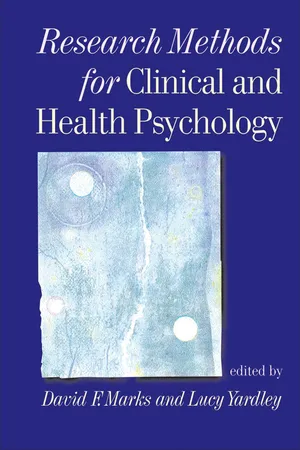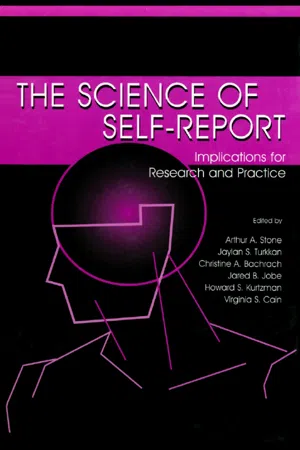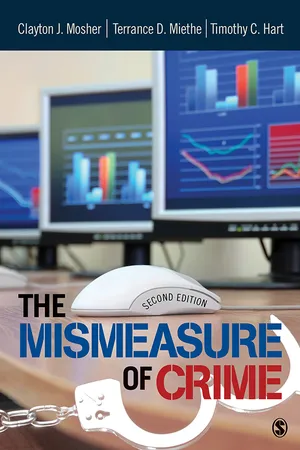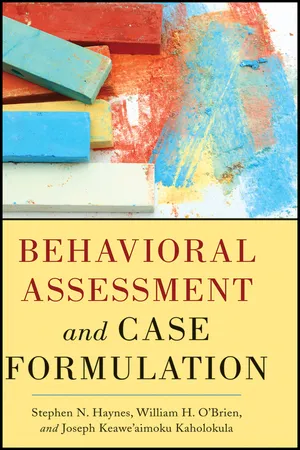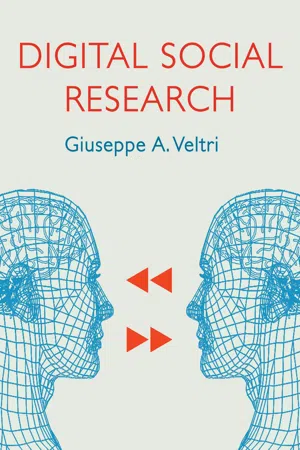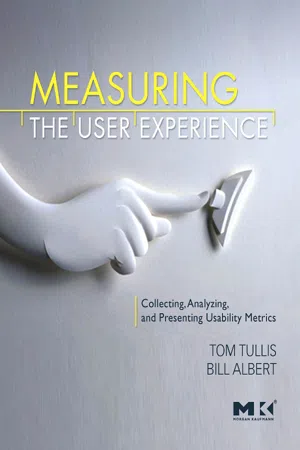Psychology
Self Report
A self-report in psychology refers to a method of gathering data where individuals provide information about their own thoughts, feelings, or behaviors. This can be done through questionnaires, interviews, or surveys. Self-reports are commonly used to assess personality traits, attitudes, and mental health symptoms, and they rely on the individual's self-awareness and ability to accurately report their experiences.
Written by Perlego with AI-assistance
Related key terms
Related key terms
1 of 4
Related key terms
1 of 3
8 Key excerpts on "Self Report"
- David F Marks, Lucy Yardley, David F Marks, Lucy Yardley(Authors)
- 2003(Publication Date)
- SAGE Publications Ltd(Publisher)
acceptability to the group under study. These matters are essential, and the final assessment of acceptability will be aided by a pilot study with a small number of representatives typical of the respondents who are expected to participate in your main study. The instrument can be fine-tuned following the feedback from the pilot sample. For example, the font size may be too small for people who are older or who have visual impairments, the instructions may be unclear, or the consent form insufficiently concise. For members of ethnic minorities or refugees, it may be necessary to produce the questionnaire in different languages, which will have implications for the validity, reliability and sensitivity of the questionnaire (see below). Note that a questionnaire may be reliable and valid for one population but not another. For example, a questionnaire designed to measure health status in cancer patients may be insensitive to smaller variations in health status in a general population sample.Questionnaire content
One of the easiest and most practical ways of assessing a person’s feelings, attitudes and behaviours is to ask them, either in interview or self-administered questionnaire.Self-reportsare therefore a primary means of obtaining psychological data. Self-reports are related to the processes of introspection and communication, which are controversial in psychology because they may be affected by all kinds of subjective and social processes that are difficult to measure and control. Self-reports are often combined with objective measures of behaviour taken by direct observation or by using neurodiagnostic techniques, such as fMRI, PET scan, CAT scan, P300, EEG, biofeedback, electromyogram or other psychophysiological methods of brain imaging. (The latter techniques are beyond the scope of this book; a useful source is Cabeza & Kingstone, 2001.)The fact remains that many of the processes that clinicians are interested in are subjective experiences and so it is practically impossible to avoid the use of the self-report. For example, feelings of pain, depression, anxiety, stress, coping, recovery, energy, fatigue, wellbeing, satisfaction, social support, self-esteem and self-efficacy are all subjectively defined experiences, which can only be assessed by self-report. Thus the century-long debate in psychology about the use of self-reports as data has had little bearing on the everyday necessity of using such data in health care diagnosis, assessment and research. However, there is a serious concern about the best ways of obtaining such data in the most reliable, valid and sensitive fashion. Examples of content from some important and frequently used questionnaires are given below.- eBook - ePub
Research Methods in Clinical Psychology
An Introduction for Students and Practitioners
- Chris Barker, Nancy Pistrang, Robert Elliott(Authors)
- 2015(Publication Date)
- Wiley-Blackwell(Publisher)
The great advantage of self-report is that it gives you the respondents’ own views directly. It gives access to phenomenological data, that is, respondents’ perceptions of themselves and their world, which are unobtainable in any other way. As Kvale and Brinkman (2009) put it, “If you want to know how people understand their world and their lives, why not talk with them?” (p. xvii). Furthermore, self-report methods can be used to obtain information in situations where observational data are not normally available, for instance, for studying life histories, or behavior during a major disaster.The main disadvantage of self-report is that there are a number of potential validity problems associated with it. The data are personal and idiosyncratic and thus may bear little relationship to “reality,” as seen by you or others. Moreover, people are not always truthful. They may deceive themselves, such as when an alcoholic cannot admit his dependency to himself, or they may deceive the researcher, such as when a young offender does not want to reveal his socially undesirable thoughts or behavior. Furthermore, research participants may not be able to provide the level of detail, or use the concepts, that the researcher is interested in. This is especially the case when people have limited expressive language, for instance, young children or people with neurological conditions such as dementia or aphasia.Arguments arising in social psychology, psychoanalysis, and cognitive psychology cast doubt upon the validity of self-reports. From the social psychological perspective of attribution theory, Nisbett and his colleagues (e.g., Nisbett & Ross, 1980; Nisbett & Wilson, 1977) have argued that people often do not know what influences their behavior, and that there are pervasive biases in the way that we account for our own and others’ behavior. One common source of bias, known as the actor-observer effect - eBook - ePub
The Science of Self-report
Implications for Research and Practice
- Arthur A. Stone, Christine A. Bachrach, Jared B. Jobe, Howard S. Kurtzman, Virginia S. Cain, Arthur A. Stone, Christine A. Bachrach, Jared B. Jobe, Howard S. Kurtzman, Virginia S. Cain(Authors)
- 1999(Publication Date)
- Psychology Press(Publisher)
PART VISELF-REPORTING OF HEALTH BEHAVIORS AND PSYCHIATRIC SYMPTOMS
Howard S.Kurtzman National Institute of Mental HealthSelf-reports are a crucial—often the only—source of information about psychiatric symptoms and health behaviors. But until recently, the validity and reliability of self-reports in these domains have been inadequate. As the authors in this section show, improved methods for eliciting self-reports are now being developed that take into account the processes by which subjects understand and respond to self-report requests.Kessler, Wittchen, Abelson, and Zhao aim to improve the design of structured interviews for detecting psychiatric disorders in large community samples. Their recommendations address four determinants of subjects’ Self Reports: (a) Question comprehension: Questions should be phrased carefully to minimize vagueness and complexity and to clarify relations with preceding questions; (b) Task comprehension: It should be made clear to subjects whether, for example, a question is calling for an effortful search of memory or is only requesting easily accessible information; (c) Motivation: Subjects should be informed of the rationale for the interview, asked for an overt commitment to cooperate, and given verbal reinforcement throughout the interview; and (d) Ability to answer accurately: Questions should be structured in ways that encourage retrieval of specific autobio-graphical information rather than potentially biased inference or estimation about life events; also, more difficult memory searches should be placed at the beginning of the interview, before subjects’ energy wanes. As the authors describe, implementation of these recommendations in the U.S. National Comorbidity Survey appears to have yielded more effective detection of mental disorders.Rand focuses on self-reports of adherence to drug and other therapeutic regimens. She points out that self-reports have many potential advantages, such as providing detailed information about a patient’s pattern of adherence and the personal and situational factors that determine that pattern. But the accuracy of self-reports can be compromised by such factors as memory distortions and motives to provide socially desirable responses. Rand calls for systematic research to develop improved self-report instruments for assessing adherence in adults and children; these instruments would include items about the patient’s beliefs and attitudes concerning adherence and about specific barriers to adherence. She also points to research on physicians’ communication skills that suggests that direct, specific, but nonjudgmental questioning can increase the accuracy of self-reports in clinical settings. - eBook - ePub
- Clayton Mosher, Terance D. Miethe, Timothy Christopher Hart(Authors)
- 2010(Publication Date)
- SAGE Publications, Inc(Publisher)
SELF-REPORT STUDIESRespondents are a tricky bunch, and they do not always behave the way a researcher would wish or expect. In fact, surveys would be far more reliable without them.—Coleman & Moynihan (1996, p. 77)S elf-report studies of crime were developed in the 1940s and 1950s, largely in response to concerns among criminologists that official measures of crime were systematically biased and provided a distorted picture of the nature and extent of crime and its correlates.One of the primary advantages of self-report studies is that the information individuals provide regarding their behavior is not filtered through any official or judicial process. The criminal justice funnel, which illustrates how, at each stage of the system, fewer and fewer illegal behaviors are siphoned off for official crime counts, does not operate with respect to self-report data.However, what individuals tell us about their behavior may or may not be a reliable and valid source for determining how involved they are in criminal activity. Memories of events—even of ones as dramatic as criminal episodes— may be fuzzy rather than clear, especially when it comes to recollecting the time period in which they occurred or the sequence of their occurrence. The questions that researchers ask may be phrased in ways that are different from the way people think of their behavior. For example, asking “In the past six months, have you abused or aggressed against a family member?” may elicit a different response than “In the past six months, have you slapped, hit, or punched anyone in your house?” Even with good nonjudgmental questions,however, respondents may be reluctant to answer fully and truthfully—at least partially because of the fact that they are being asked to admit to behaviors that might result in their arrest if the actions became known to authorities.One purpose of this chapter is to make you a savvy consumer, as well as evaluator, of self-report measures of crime. Because of its importance to both self-report and victimization data, we begin with a brief discussion of survey methodology. We then review the methodology and findings of some of the more prominent self-report studies, including the National Youth Survey (NYS), the National Longitudinal Study of Adolescent Health (Add Health), the Monitoring the Future (MTF) Survey, and the National Household Survey on Drug Abuse (NHSDA, now known as the National Survey on Drug Use and Health [NSDUH]). This is followed by a review of a prominent and enduring debate in the discipline of criminology regarding the connection between social class and crime, a debate that led to further refinements and improvements in self-report methodology. We then discuss self-report data from known offenders, which have provided particular insights into the crime patterns of individuals who have been apprehended by the criminal justice system. The chapter concludes with an examination of studies focusing on the reliability of self-reported data on drug use. - eBook - ePub
- Stephen N. Haynes, William O'Brien, Joseph Kaholokula(Authors)
- 2011(Publication Date)
- Wiley(Publisher)
Chapter 8 Self-Report Methods in Behavioral Assessment OVERVIEW OF SELF-REPORT BEHAVIORAL ASSESSMENT METHODS AND STRATEGIESThe case of Mrs. Anderson that we describe in Chapter 7 illustrates how behavioral assessment methods and strategies are consistent with the principles of the behavioral assessment paradigm and the functional analysis. Behavioral assessment emphasizes the use of minimally inferential and clearly defined measures of behavior and related events that have well-developed psychometric properties, are sensitive to change, and appropriate for the characteristics of an individual client and the assessment context. Additionally, the behavioral assessment paradigm encourages the measurement of multiple response modes, dimensions, and attributes of a behavior, using a level of specificity that is most applicable to the problem behavior under investigation and the goals of the assessment. There is an assumption that the most accurate and valid information will be obtained when assessments include multiple informants, multiple measurement methods, and data collection in multiple settings.In this chapter, we discuss a subset of behavioral assessment methods: those that rely on self-report. There are several types of self-report methods, including behavioral interviews, questionnaires, and self-monitoring using a daily log or an electronic diary. We refer the reader to Hersen (2006a, 2006b), Fernández-Ballesteros (2004), and Fernández-Ballesteros and Botella (2008) for an elaboration on the self-report methods discussed in this chapter.Self-report assessment methods are used across all psychological assessment paradigms because they can easily be administrated in most settings, are flexible in their clinical applicability and utility, and are relatively cost- and time-efficient compared to direct observational and psychophysiological methods of assessment. Additionally, self-report methods are the only way that a client’s cognitive and emotional experiences and subjective appraisal of causal relations can be ascertained. Although there are self-report assessment methods that assess personality traits and unconscious processes, behavioral assessment focuses on more specific and measurable behaviors and events that allow for the specification of a client’s behavior problems and of relevant functional relations. - eBook - ePub
- Giuseppe A. Veltri(Author)
- 2019(Publication Date)
- Polity(Publisher)
Both models look primarily at people’s conscious thought processes and determine what they think, believe and how they act. Deviation from either economic rationality or forms of ‘sociological rationality’ were labelled as ‘irrational’. In such a context, the way to elicit data and study people’s behaviour relies on what people themselves report, about their opinions, social norms, attitudes and beliefs. These are often defined as ‘self-reported’ data, meaning that researchers rely on participants of a study to report on something they have done or on what they think or believe. Surveys and interviews of all sorts are examples of self-reported data. In contrast to this approach, there are observational or behavioural data, data about the actual actions and behaviour carried out by someone. To better appreciate the difference, let’s take the example of asking someone how many times she or he goes to the gym every month, and compare the response to the actual tracking of their movements, for example, on a GPS phone or watch. The two pieces of information can differ dramatically. Researchers in the social sciences have learned to live with limitations of self-reported data, such as the social desirability bias (Kreuter et al., 2009). The concept of social desirability rests on the notion that there are social norms governing some behaviours and attitudes and that people may misrepresent themselves in order to appear to comply with these norms. This is the reason why participants might provide inaccurate information about their behaviour to researchers. At the same time, people have difficulty in verbalizing accurately what they have done, felt and thought. Recalling events from memory is not easy either (Gaskell et al., 2000). In other words, self-reported measures have their limitations, but they have been the most common way of conducting social research related to human behaviour.However, the biggest challenge to self-reported data has come from a shift in the model of human behaviour. Since the late 1990s, psychologists have distinguished between two systems of thought with different capacities and processes (Kahneman, 2011; Kahneman and Frederick, 2002; Metcalfe and Mischel, 1999; Sloman, 1996; Smith and DeCoster, 2000; Lichtenstein and Slovic, 2006), which have been referred to as System 1 and System 2 (Evans and Stanovich, 2013). System 1 (S1) is made up of intuitive thoughts of great capacity, is based on associations acquired through experience and quickly and automatically calculates information. System 2 (S2), on the other hand, involves low-capacity reflective thinking, is based on rules acquired through culture or formal learning, and calculates information in a relatively slow and controlled manner. The processes associated with these systems have been defined as Type 1 (fast, automatic, unconscious) and Type 2 (slow, conscious, controlled) respectively (see Table 1.1 ). The perspective of the dual system became increasingly popular, even outside the academy, after the publication of Daniel Kahneman’s book Thinking, Fast and Slow - eBook - ePub
- Gary Groth-Marnat, A. Jordan Wright(Authors)
- 2016(Publication Date)
- Wiley(Publisher)
Chapter 15 The Psychological ReportThe psychological report is one of the most important end products of assessment. It represents the clinician's efforts to integrate the assessment data into a functional whole so that the information can help the client improve his or her life, helping to solve problems and make decisions. Even the best tests are useless unless the data from them are explained in a manner that is relevant and clear and that meets the needs of the client and referral source. Doing this requires clinicians to give not merely test results, but also to interact with their data in a way that makes the conclusions useful in answering the referral questions and making recommendations.An evaluation can be written in many different ways. The manner of presentation depends on the purpose for which the report is intended as well as on the individual style and orientation of the practitioner. The format provided in this chapter is merely a suggested outline that follows common and traditional guidelines. It includes methods for elaborating on essential areas, such as the referral question, behavioral observations, relevant history, impressions (interpretations), and recommendations. This format is especially appropriate for clinical evaluations that are problem-oriented and that offer specific prescriptions for change. Additional alternatives for organizing the report are to use a letter format, give only the summary and recommendations, focus on a specific problem, summarize the results test by test (though this is discouraged, as discussed later in this chapter), write directly to the client, or provide client descriptions around a particular theory of personality. The sample evaluations vary somewhat from the suggested format, although they usually still include the essential categories of information that are discussed in this chapter. - eBook - ePub
Measuring the User Experience
Collecting, Analyzing, and Presenting Usability Metrics
- Bill Albert, Tom Tullis(Authors)
- 2010(Publication Date)
- Morgan Kaufmann(Publisher)
Chapter 6 Self-Reported MetricsPerhaps the most obvious way to learn about the usability of something is to ask users to tell you about their experience with it. But exactly how to ask them so that you get good data is not so obvious. The questions you might ask could take on many forms, including various kinds of rating scales, lists of attributes that the participants could choose from, and open-ended questions like “List the top three things you liked the most about this application.” Some of the attributes you might ask about include overall satisfaction, ease of use, effectiveness of navigation, awareness of certain features, clarity of terminology, visual appeal, and many others. But the common feature of all of these is that you’re asking the participant for information, which is why we think self-reported metrics is the best term to use.Two other terms sometimes used to describe this kind of data include subjective data and preference data. Subjective is used as a counterpart to objective , which is often used to describe the performance data from a usability study. But this implies that there’s a lack of objectivity to the data you’re collecting. Yes, it may be subjective to each participant who’s providing the input, but from the perspective of the usability specialist, it is completely objective. Similarly, preference is often used as a counterpart to performance . Although there’s nothing obviously wrong with that, we believe that preference implies a choice of one option over another, which is often not the case in usability studies.6.1 IMPORTANCE OF SELF-REPORTED DATA
Self-reported data give you the most important information about users’ perception of the system and their interaction with it. At an emotional level, the data may even tell you something about how the users feel
Index pages curate the most relevant extracts from our library of academic textbooks. They’ve been created using an in-house natural language model (NLM), each adding context and meaning to key research topics.
Explore more topic indexes
Explore more topic indexes
1 of 6
Explore more topic indexes
1 of 4
